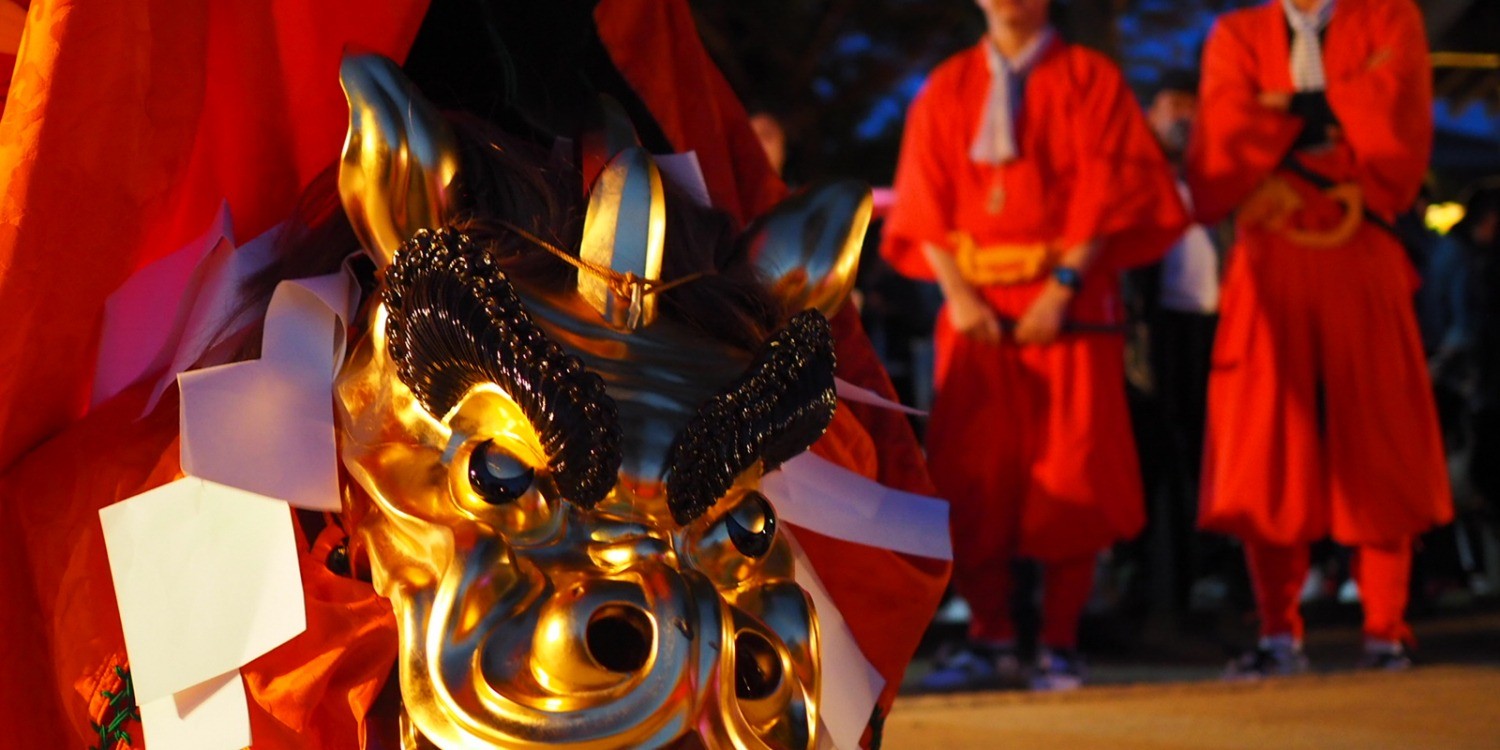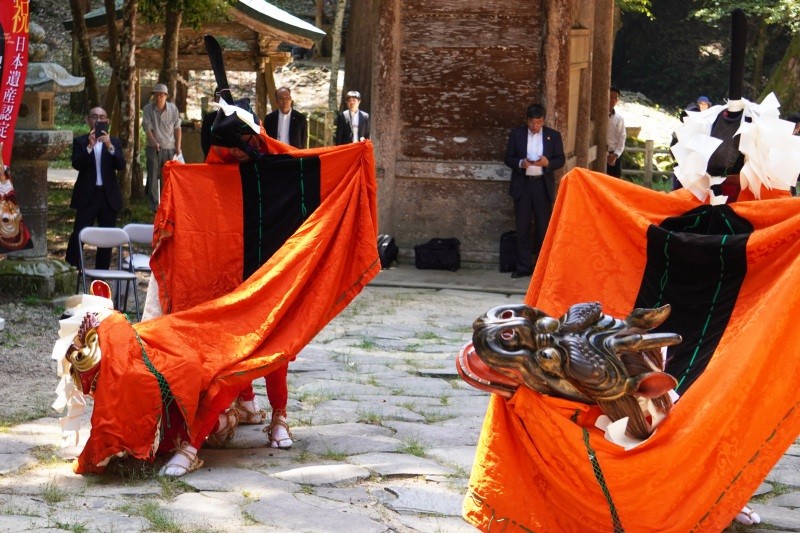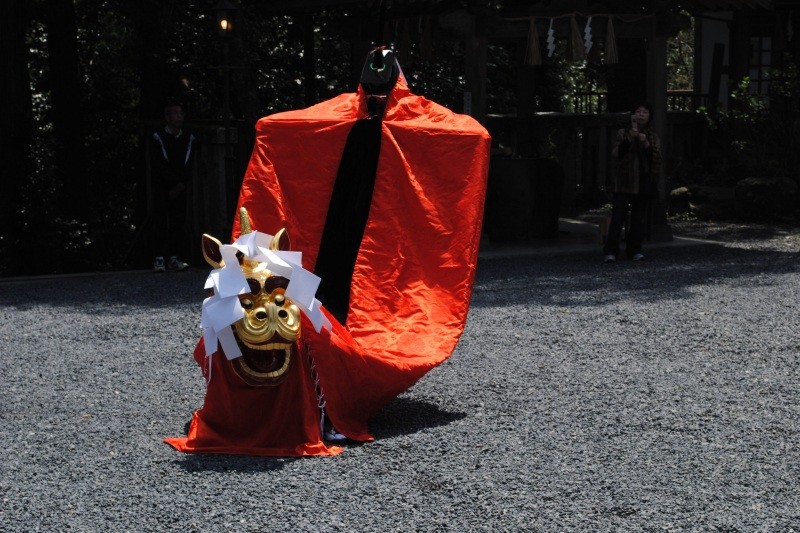Cultural Properties-Kirin Dance-
The Kirin Lion Dance, performed with gratitude and prayers for safety in the season of wind.
The Kirin Shishimai (Kirin Lion Dance) is a two-person lion dance performed by two adults inside a long body cloth called a kaya, with one of them wearing a lion's head modeled after the mythical beast, the kirin (a benevolent, divine creature in East Asian folklore). Typically, a single lion performs slow, ground-level movements such as turning its head, twisting, or rearing up—characteristic gestures that embody both grace and strength.
The head of the kirin lion is elongated, with a horn on its forehead and upright ears. True to its nickname “sleeping lion” (nemuri-jishi), its eyes are closed, while its large nostrils face upward, giving it a somewhat humorous and gentle expression.
While traditional lion dances are often accompanied by mystical figures like tengu (goblin-like spirits), the Kirin Shishimai is uniquely accompanied by a figure known as a Shōjō—a red-faced, red-haired spirit dressed in red robes. The Shōjō holds a red staff approximately 1.5 meters long and either leads the kirin lion or performs slow, graceful movements alongside it.

The Kirin Lion Dance, passed down for 370 years
In this region, the Kirin Lion Dance, featuring a golden lion head with a single horn and performers clad in scarlet costumes, has been passed down and performed in around 180 villages.
The kirin is a mythical creature from Chinese tradition, symbolizing a peaceful world where no living being is harmed. About 370 years ago, the dance first appeared in the form of a lion with the face of a kirin during a festival held at a shrine established by Mitsunaka Ikeda, the first lord of the Tottori Domain, to honor his great ancestor, Tokugawa Ieyasu.
Captivated by the dazzling appearance of the Kirin Lion, the people wished to bring this auspicious figure—believed to bring happiness—into their own village festivals. Over time, as it spread throughout the region, the Kirin Lion Dance evolved with each village, developing its own unique expressions in both the face of the lion and the style of the dance.
The Wisdom and History of People Living with the Wind
While the wind has bestowed upon people the gifts of sand, waves, and snow, it has also imposed a life of facing harsh natural elements such as blowing sand, rough seas, and heavy snowfall. With gratitude in their hearts for safely overcoming the approaching severe windy season, people have continued, since ancient times, to perform the Kirin Lion Dance—a symbol believed to bring happiness—and share that happiness even with travelers who encounter the kirin.
Inaba and Tajima are lands where people coexist with the winds blowing from the Sea of Japan. Holding the Kirin Lion Dance close to their hearts, they have embraced the harsh nature of sand, waves, and snow. Here lives the wisdom of people who have endured and thrived, living in harmony with the wind throughout history.
Japan Heritage The Kirin Dance of Inaba-Tottori Prefecture-
The Lion dance performed with a mask of the sacred Kirin made its first appearance at a festival at the Toshogu Shrine, which was built by the first feudal lord of Tottori.
This serene musical dance has been passed on in the villages of the Inaba area, with the Kirin being considered a sacred beast that brings happiness.Dancing while holding in their hearts a prayer for safety during the harsh windy seasons, as well as their gratefulness for overcoming these hard times, the Kirin brings happiness to the people living in and travelling these lands.
- Japan Heritage Tottori City's Kirin Dance-Tottori Prefecture-
- The Ube Shrine Kirin Dance Preservation Association is based in Tottori, home of the Tottori Toshogu Shrine — the birthplace of the Kirin Dance, and the central heart of "Kirinnomachi."
As the largest preservation organization in the area, it is responsible for protecting the traditional dance in all other locations. Built in the year 648, and having earned the title of ichinomiya — the highest rank possible for a Shinto shrine — both Ube Shrine and the Kirin Dance it upholds share an important pedigree. ![[ Undefined: spot-title-plain ]](/lsc/upfile/individual/0000/2361/2361_1_m.jpg)
- See More
- Japan Heritage Iwami Town's Kirin Dance-Tottori Prefecture-
- In the town of Iwami, home to the rocky coastline of San'in Kaigan Geopark, and the caverns and tunnels along the sandy white beaches of the shimmering Sea of Japan, the Kirin Dance tradition has been passed down, unbroken, for generations.
The Otani Kirin Dance Preservation Association holds their dances at Hino Shrine in the Otani area, where 300 families live and are brought together by the enthusiastic work of the association's forty members.
Mr. Noriyoshi Sawa of the association has said happily: "It's great having a connection to the local community." ![[ Undefined: spot-title-plain ]](/lsc/upfile/individual/0000/2362/2362_1_m.jpg)
- See More
- Japan Heritage Wakasa Town's Kirin Dance-Tottori Prefecture-
- Wakasa is located at the eastern tip of Tottori Prefecture, surrounded by lush forests.
With sakura trees blooming in the spring, and deep snowfall in the winter, its 3,000 residents are always close to nature. ![[ Undefined: spot-title-plain ]](/lsc/upfile/individual/0000/2363/2363_1_m.jpg)
- See More
- Japan Heritage Chizu Town's Kirin Dance-Tottori Prefecture-
- Chizu, a forestry-based town in southeast Tottori Prefecture.
The small Ashizu community of eighty families is located in Chizu.The association has nine members, and the head of the organization, Mr. Noriaki Teratani, has this to say: "In the past we had more people, but now with young people leaving the prefecture, we're just getting by." They're doing their best to keep the tradition alive, while confronting modern issues. ![[ Undefined: spot-title-plain ]](/lsc/upfile/individual/0000/2364/2364_1_m.jpg)
- See More
- Japan Heritage Yazu Town's Kirin Dance-Tottori Prefecture-
- Farming and beautiful countryside scenery are what make up Yazu Town, home of the Saitai community and the 25 members of the Sawa Shrine Kirin Dance Preservation Association, all of whom are aged 35 to 58.
Ms. Hiromi Tanaka, the head of the association, has said: "We came close to closing up two years ago due to the aging population, but we pulled through and are still here." In 1998, the Kirin Dance was designated as a prefectural intangible folk-cultural property, the only one in Yazu Town. ![[ Undefined: spot-title-plain ]](/lsc/upfile/individual/0000/2365/2365_1_m.jpg)
- See More
Japan Heritage The Kirin Dance of Tajima-Hyogo Prefecture-
The Kirin Dance has also been passed on in Kami Town and Shinonsen Town of the Tajima area, with the Kirin being considered a sacred beast that brings happiness. Different from the dance of the Inaba region, it is performed here as a rhythmical musical dance.
Dancing while holding in their hearts a prayer for safety during the harsh windy seasons, as well as their gratefulness for overcoming these hard times, the Kirin brings happiness to the people living in and travelling these lands.
- Japan Heritage Kami Town's Kirin Dance-Hyogo Prefecture-
- Nestled in the eastern part of Tottori Prefecture is a little place called Yoroi, part of the Kasumi District in Kami Town.
This fishing community, home to 50 families, has carried on the tradition of the Kirin Dance since it was first performed there in 1912, to celebrate the completion of the local Amarube Viaduct railway bridge.
Mr. Masanobu Fujiwara, the head of the association, has said proudly of the local culture: "Since it's a Japan heritage, many people have come to see the dance, and I'm happy to see the communication it has fostered." ![[ Undefined: spot-title-plain ]](/lsc/upfile/individual/0000/2366/2366_1_m.jpg)
- See More
- Japan Heritage Shinonsen Town's Kirin Dance-Hyogo Prefecture-
- Shinonsen Town, which was formed in 2005 by the merger of Hamasaka Town and Onsen Town.
Moroyose is a community of 300 families within Shinonsen Town.There, the Iyonaga Shrine holds its summer festival every July 14th and 15th, which is when the Kirin Dance takes place.
Mr. Mitsugu Tanaka, the head of the preservation association, has said this about generations coming together to keep the tradition going: "Here, everyone from the elderly to the children loves the Kirin Dance. It's just not a festival without it." ![[ Undefined: spot-title-plain ]](/lsc/upfile/individual/0000/2367/2367_1_m.jpg)
- See More


